
PowerInfer
High-speed Large Language Model Serving on PCs with Consumer-grade GPUs
Stars: 7584
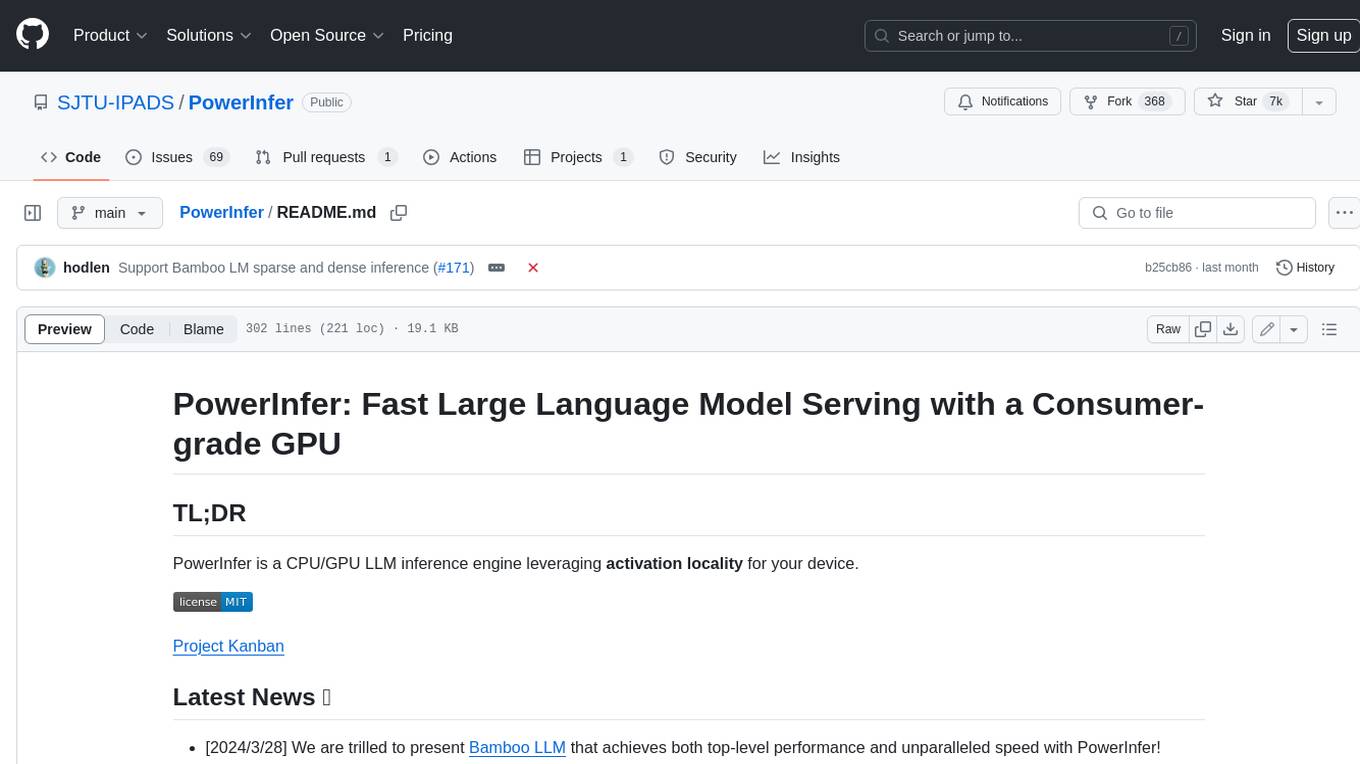
PowerInfer is a high-speed Large Language Model (LLM) inference engine designed for local deployment on consumer-grade hardware, leveraging activation locality to optimize efficiency. It features a locality-centric design, hybrid CPU/GPU utilization, easy integration with popular ReLU-sparse models, and support for various platforms. PowerInfer achieves high speed with lower resource demands and is flexible for easy deployment and compatibility with existing models like Falcon-40B, Llama2 family, ProSparse Llama2 family, and Bamboo-7B.
README:
PowerInfer is a CPU/GPU LLM inference engine leveraging activation locality for your device.
- [2024/6/11] We are thrilled to introduce PowerInfer-2, our highly optimized inference framework designed specifically for smartphones. With TurboSparse-Mixtral-47B, it achieves an impressive speed of 11.68 tokens per second, which is up to 22 times faster than other state-of-the-art frameworks.
- [2024/6/11] We are thrilled to present Turbo Sparse, our TurboSparse models for fast inference. With just $0.1M, we sparsified the original Mistral and Mixtral model to nearly 90% sparsity while maintaining superior performance! For a Mixtral-level model, our TurboSparse-Mixtral activates only 4B parameters!
- [2024/5/20] Competition Recruitment: CCF-TCArch Customized Computing Challenge 2024. The CCF TCARCH CCC is a national competition organized by the Technical Committee on Computer Architecture (TCARCH) of the China Computer Federation (CCF). This year's competition aims to optimize the PowerInfer inference engine using the open-source ROCm/HIP. More information about the competition can be found here.
- [2024/5/17] We now provide support for AMD devices with ROCm. (WIP for models exceeding 40B).
- [2024/3/28] We are trilled to present Bamboo LLM that achieves both top-level performance and unparalleled speed with PowerInfer! Experience it with Bamboo-7B Base / DPO.
- [2024/3/14] We supported ProSparse Llama 2 (7B/13B), ReLU models with ~90% sparsity, matching original Llama 2's performance (Thanks THUNLP & ModelBest)!
- [2024/1/11] We supported Windows with GPU inference!
- [2023/12/24] We released an online gradio demo for Falcon(ReLU)-40B-FP16!
- [2023/12/19] We officially released PowerInfer!
https://github.com/SJTU-IPADS/PowerInfer/assets/34213478/fe441a42-5fce-448b-a3e5-ea4abb43ba23
PowerInfer v.s. llama.cpp on a single RTX 4090(24G) running Falcon(ReLU)-40B-FP16 with a 11x speedup!
Both PowerInfer and llama.cpp were running on the same hardware and fully utilized VRAM on RTX 4090.
[!NOTE] Live Demo Online⚡️
Try out our Gradio server hosting Falcon(ReLU)-40B-FP16 on a RTX 4090!
Experimental and without warranties 🚧
We introduce PowerInfer, a high-speed Large Language Model (LLM) inference engine on a personal computer (PC) equipped with a single consumer-grade GPU. The key underlying the design of PowerInfer is exploiting the high locality inherent in LLM inference, characterized by a power-law distribution in neuron activation.
This distribution indicates that a small subset of neurons, termed hot neurons, are consistently activated across inputs, while the majority, cold neurons, vary based on specific inputs. PowerInfer exploits such an insight to design a GPU-CPU hybrid inference engine: hot-activated neurons are preloaded onto the GPU for fast access, while cold-activated neurons are computed on the CPU, thus significantly reducing GPU memory demands and CPU-GPU data transfers. PowerInfer further integrates adaptive predictors and neuron-aware sparse operators, optimizing the efficiency of neuron activation and computational sparsity.
Evaluation shows that PowerInfer attains an average token generation rate of 13.20 tokens/s, with a peak of 29.08 tokens/s, across various LLMs (including OPT-175B) on a single NVIDIA RTX 4090 GPU, only 18% lower than that achieved by a top-tier server-grade A100 GPU. This significantly outperforms llama.cpp by up to 11.69x while retaining model accuracy.
PowerInfer is a high-speed and easy-to-use inference engine for deploying LLMs locally.
PowerInfer is fast with:
- Locality-centric design: Utilizes sparse activation and 'hot'/'cold' neuron concept for efficient LLM inference, ensuring high speed with lower resource demands.
- Hybrid CPU/GPU Utilization: Seamlessly integrates memory/computation capabilities of CPU and GPU for a balanced workload and faster processing.
PowerInfer is flexible and easy to use with:
- Easy Integration: Compatible with popular ReLU-sparse models.
- Local Deployment Ease: Designed and deeply optimized for local deployment on consumer-grade hardware, enabling low-latency LLM inference and serving on a single GPU.
-
Backward Compatibility: While distinct from llama.cpp, you can make use of most of
examples/the same way as llama.cpp such as server and batched generation. PowerInfer also supports inference with llama.cpp's model weights for compatibility purposes, but there will be no performance gain.
You can use these models with PowerInfer today:
- Falcon-40B
- Llama2 family
- ProSparse Llama2 family
- Bamboo-7B
We have tested PowerInfer on the following platforms:
- x86-64 CPUs with AVX2 instructions, with or without NVIDIA GPUs, under Linux.
- x86-64 CPUs with AVX2 instructions, with or without NVIDIA GPUs, under Windows.
- Apple M Chips (CPU only) on macOS. (As we do not optimize for Mac, the performance improvement is not significant now.)
And new features coming soon:
- Metal backend for sparse inference on macOS
Please kindly refer to our Project Kanban for our current focus of development.
PowerInfer requires the following dependencies:
- CMake (3.17+)
- Python (3.8+) and pip (19.3+), for converting model weights and automatic FFN offloading
git clone https://github.com/SJTU-IPADS/PowerInfer
cd PowerInfer
pip install -r requirements.txt # install Python helpers' dependenciesIn order to build PowerInfer you have two different options. These commands are supposed to be run from the root directory of the project.
Using CMake(3.17+):
- If you have an NVIDIA GPU:
cmake -S . -B build -DLLAMA_CUBLAS=ON
cmake --build build --config Release- If you have an AMD GPU:
# Replace '1100' to your card architecture name, you can get it by rocminfo
CC=/opt/rocm/llvm/bin/clang CXX=/opt/rocm/llvm/bin/clang++ cmake -S . -B build -DLLAMA_HIPBLAS=ON -DAMDGPU_TARGETS=gfx1100
cmake --build build --config Release- If you have just CPU:
cmake -S . -B build
cmake --build build --config ReleasePowerInfer models are stored in a special format called PowerInfer GGUF based on GGUF format, consisting of both LLM weights and predictor weights.
You can obtain PowerInfer GGUF weights at *.powerinfer.gguf as well as profiled model activation statistics for 'hot'-neuron offloading from each Hugging Face repo below.
| Base Model | PowerInfer GGUF |
|---|---|
| LLaMA(ReLU)-2-7B | PowerInfer/ReluLLaMA-7B-PowerInfer-GGUF |
| LLaMA(ReLU)-2-13B | PowerInfer/ReluLLaMA-13B-PowerInfer-GGUF |
| Falcon(ReLU)-40B | PowerInfer/ReluFalcon-40B-PowerInfer-GGUF |
| LLaMA(ReLU)-2-70B | PowerInfer/ReluLLaMA-70B-PowerInfer-GGUF |
| ProSparse-LLaMA-2-7B | PowerInfer/ProSparse-LLaMA-2-7B-GGUF |
| ProSparse-LLaMA-2-13B | PowerInfer/ProSparse-LLaMA-2-13B-GGUF |
| Bamboo-base-7B 🌟 | PowerInfer/Bamboo-base-v0.1-gguf |
| Bamboo-DPO-7B 🌟 | PowerInfer/Bamboo-DPO-v0.1-gguf |
We recommend using huggingface-cli to download the whole model repo. For example, the following command will download PowerInfer/ReluLLaMA-7B-PowerInfer-GGUF into the ./ReluLLaMA-7B directory.
huggingface-cli download --resume-download --local-dir ReluLLaMA-7B --local-dir-use-symlinks False PowerInfer/ReluLLaMA-7B-PowerInfer-GGUFAs such, PowerInfer can automatically make use of the following directory structure for feature-complete model offloading:
.
├── *.powerinfer.gguf (Unquantized PowerInfer model)
├── *.q4.powerinfer.gguf (INT4 quantized PowerInfer model, if available)
├── activation (Profiled activation statistics for fine-grained FFN offloading)
│ ├── activation_x.pt (Profiled activation statistics for layer x)
│ └── ...
├── *.[q4].powerinfer.gguf.generated.gpuidx (Generated GPU index at runtime for corresponding model)
Hugging Face limits single model weight to 50GiB. For unquantized models >= 40B, you can convert PowerInfer GGUF from the original model weights and predictor weights obtained from Hugging Face.
| Base Model | Original Model | Predictor |
|---|---|---|
| LLaMA(ReLU)-2-7B | SparseLLM/ReluLLaMA-7B | PowerInfer/ReluLLaMA-7B-Predictor |
| LLaMA(ReLU)-2-13B | SparseLLM/ReluLLaMA-13B | PowerInfer/ReluLLaMA-13B-Predictor |
| Falcon(ReLU)-40B | SparseLLM/ReluFalcon-40B | PowerInfer/ReluFalcon-40B-Predictor |
| LLaMA(ReLU)-2-70B | SparseLLM/ReluLLaMA-70B | PowerInfer/ReluLLaMA-70B-Predictor |
| ProSparse-LLaMA-2-7B | SparseLLM/ProSparse-LLaMA-2-7B | PowerInfer/ProSparse-LLaMA-2-7B-Predictor |
| ProSparse-LLaMA-2-13B | SparseLLM/ProSparse-LLaMA-2-13B | PowerInfer/ProSparse-LLaMA-2-13B-Predictor |
| Bamboo-base-7B 🌟 | PowerInfer/Bamboo-base-v0.1 | PowerInfer/Bamboo-base-v0.1-predictor |
| Bamboo-DPO-7B 🌟 | PowerInfer/Bamboo-DPO-v0.1 | PowerInfer/Bamboo-DPO-v0.1-predictor |
You can use the following command to convert the original model weights and predictor weights to PowerInfer GGUF:
# make sure that you have done `pip install -r requirements.txt`
python convert.py --outfile /PATH/TO/POWERINFER/GGUF/REPO/MODELNAME.powerinfer.gguf /PATH/TO/ORIGINAL/MODEL /PATH/TO/PREDICTOR
# python convert.py --outfile ./ReluLLaMA-70B-PowerInfer-GGUF/llama-70b-relu.powerinfer.gguf ./SparseLLM/ReluLLaMA-70B ./PowerInfer/ReluLLaMA-70B-PredictorFor the same reason, we suggest keeping the same directory structure as PowerInfer GGUF repos after conversion.
Convert Original models into dense GGUF models(compatible with llama.cpp)
python convert-dense.py --outfile /PATH/TO/DENSE/GGUF/REPO/MODELNAME.gguf /PATH/TO/ORIGINAL/MODEL
# python convert-dense.py --outfile ./Bamboo-DPO-v0.1-gguf/bamboo-7b-dpo-v0.1.gguf --outtype f16 ./Bamboo-DPO-v0.1Please note that the generated dense GGUF models might not work properly with llama.cpp, as we have altered activation functions (for ReluLLaMA and Prosparse models), or the model architecture (for Bamboo models). The dense GGUF models generated by convert-dense.py can be used for PowerInfer in dense inference mode, but might not work properly with llama.cpp.
For CPU-only and CPU-GPU hybrid inference with all available VRAM, you can use the following instructions to run PowerInfer:
./build/bin/main -m /PATH/TO/MODEL -n $output_token_count -t $thread_num -p $prompt
# e.g.: ./build/bin/main -m ./ReluFalcon-40B-PowerInfer-GGUF/falcon-40b-relu.q4.powerinfer.gguf -n 128 -t 8 -p "Once upon a time"
# For Windows: .\build\bin\Release\main.exe -m .\ReluFalcon-40B-PowerInfer-GGUF\falcon-40b-relu.q4.powerinfer.gguf -n 128 -t 8 -p "Once upon a time"If you want to limit the VRAM usage of GPU:
./build/bin/main -m /PATH/TO/MODEL -n $output_token_count -t $thread_num -p $prompt --vram-budget $vram_gb
# e.g.: ./build/bin/main -m ./ReluLLaMA-7B-PowerInfer-GGUF/llama-7b-relu.powerinfer.gguf -n 128 -t 8 -p "Once upon a time" --vram-budget 8
# For Windows: .\build\bin\Release\main.exe -m .\ReluLLaMA-7B-PowerInfer-GGUF\llama-7b-relu.powerinfer.gguf -n 128 -t 8 -p "Once upon a time" --vram-budget 8Under CPU-GPU hybrid inference, PowerInfer will automatically offload all dense activation blocks to GPU, then split FFN and offload to GPU if possible.
Dense inference mode (limited support)
If you want to run PowerInfer to infer with the dense variants of the PowerInfer model family, you can use similarly as llama.cpp does:
./build/bin/main -m /PATH/TO/DENSE/MODEL -n $output_token_count -t $thread_num -p $prompt -ngl $num_gpu_layers
# e.g.: ./build/bin/main -m ./Bamboo-base-v0.1-gguf/bamboo-7b-v0.1.gguf -n 128 -t 8 -p "Once upon a time" -ngl 12So is the case for other examples/ like server and batched_generation. Please note that the dense inference mode is not a "compatible mode" for all models. We have altered activation functions (for ReluLLaMA and Prosparse models) in this mode to match with our model family.
PowerInfer supports serving and batched generation with the same instructions as llama.cpp. Generally, you can use the same command as llama.cpp, except for -ngl argument which has been replaced by --vram-budget for PowerInfer. Please refer to the detailed instructions in each examples/ directory. For example:
PowerInfer has optimized quantization support for INT4(Q4_0) models. You can use the following instructions to quantize PowerInfer GGUF model:
./build/bin/quantize /PATH/TO/MODEL /PATH/TO/OUTPUT/QUANTIZED/MODEL Q4_0
# e.g.: ./build/bin/quantize ./ReluFalcon-40B-PowerInfer-GGUF/falcon-40b-relu.powerinfer.gguf ./ReluFalcon-40B-PowerInfer-GGUF/falcon-40b-relu.q4.powerinfer.gguf Q4_0
# For Windows: .\build\bin\Release\quantize.exe .\ReluFalcon-40B-PowerInfer-GGUF\falcon-40b-relu.powerinfer.gguf .\ReluFalcon-40B-PowerInfer-GGUF\falcon-40b-relu.q4.powerinfer.gguf Q4_0Then you can use the quantized model for inference with PowerInfer with the same instructions as above.
We evaluated PowerInfer vs. llama.cpp on a single RTX 4090(24G) with a series of FP16 ReLU models under inputs of length 64, and the results are shown below. PowerInfer achieves up to 11x speedup on Falcon 40B and up to 3x speedup on Llama 2 70B.
The X axis indicates the output length, and the Y axis represents the speedup compared with llama.cpp. The number above each bar indicates the end-to-end generation speed (total prompting + generation time / total tokens generated, in tokens/s).
We also evaluated PowerInfer on a single RTX 2080Ti(11G) with INT4 ReLU models under inputs of length 8, and the results are illustrated in the same way as above. PowerInfer achieves up to 8x speedup on Falcon 40B and up to 3x speedup on Llama 2 70B.
Please refer to our paper for more evaluation details.
-
What if I encountered
CUDA_ERROR_OUT_OF_MEMORY?- You can try to run with
--reset-gpu-indexargument to rebuild the GPU index for this model to avoid any stale cache. - Due to our current implementation, model offloading might not be as accurate as expected. You can try with
--vram-budgetwith a slightly lower value or--disable-gpu-indexto disable FFN offloading.
- You can try to run with
-
Does PowerInfer support mistral, original llama, Qwen, ...?
- Now we only support models with ReLU/ReGLU/Squared ReLU activation function. So we do not support these models now. It's worth mentioning that a paper has demonstrated that using the ReLU/ReGLU activation function has a negligible impact on convergence and performance.
-
Why is there a noticeable downgrade in the performance metrics of our current ReLU model, particularly the 70B model?
- In contrast to the typical requirement of around 2T tokens for LLM training, our model's fine-tuning was conducted with only 5B tokens. This insufficient retraining has resulted in the model's inability to regain its original performance. We are actively working on updating to a more capable model, so please stay tuned.
-
What if...
- Issues are welcomed! Please feel free to open an issue and attach your running environment and running parameters. We will try our best to help you.
We will release the code and data in the following order, please stay tuned!
- [x] Release core code of PowerInfer, supporting Llama-2, Falcon-40B.
- [x] Support
Mistral-7B(Bamboo-7B) - [x] Support Windows
- [ ] Support text-generation-webui
- [x] Release perplexity evaluation code
- [ ] Support Metal for Mac
- [ ] Release code for OPT models
- [ ] Release predictor training code
- [x] Support online split for FFN network
- [ ] Support Multi-GPU
More technical details can be found in our paper.
If you find PowerInfer useful or relevant to your project and research, please kindly cite our paper:
@misc{song2023powerinfer,
title={PowerInfer: Fast Large Language Model Serving with a Consumer-grade GPU},
author={Yixin Song and Zeyu Mi and Haotong Xie and Haibo Chen},
year={2023},
eprint={2312.12456},
archivePrefix={arXiv},
primaryClass={cs.LG}
}We are thankful for the easily modifiable operator library ggml and execution runtime provided by llama.cpp. We also extend our gratitude to THUNLP for their support of ReLU-based sparse models. We also appreciate the research of Deja Vu, which inspires PowerInfer.
For Tasks:
Click tags to check more tools for each tasksFor Jobs:
Alternative AI tools for PowerInfer
Similar Open Source Tools

PowerInfer
PowerInfer is a high-speed Large Language Model (LLM) inference engine designed for local deployment on consumer-grade hardware, leveraging activation locality to optimize efficiency. It features a locality-centric design, hybrid CPU/GPU utilization, easy integration with popular ReLU-sparse models, and support for various platforms. PowerInfer achieves high speed with lower resource demands and is flexible for easy deployment and compatibility with existing models like Falcon-40B, Llama2 family, ProSparse Llama2 family, and Bamboo-7B.
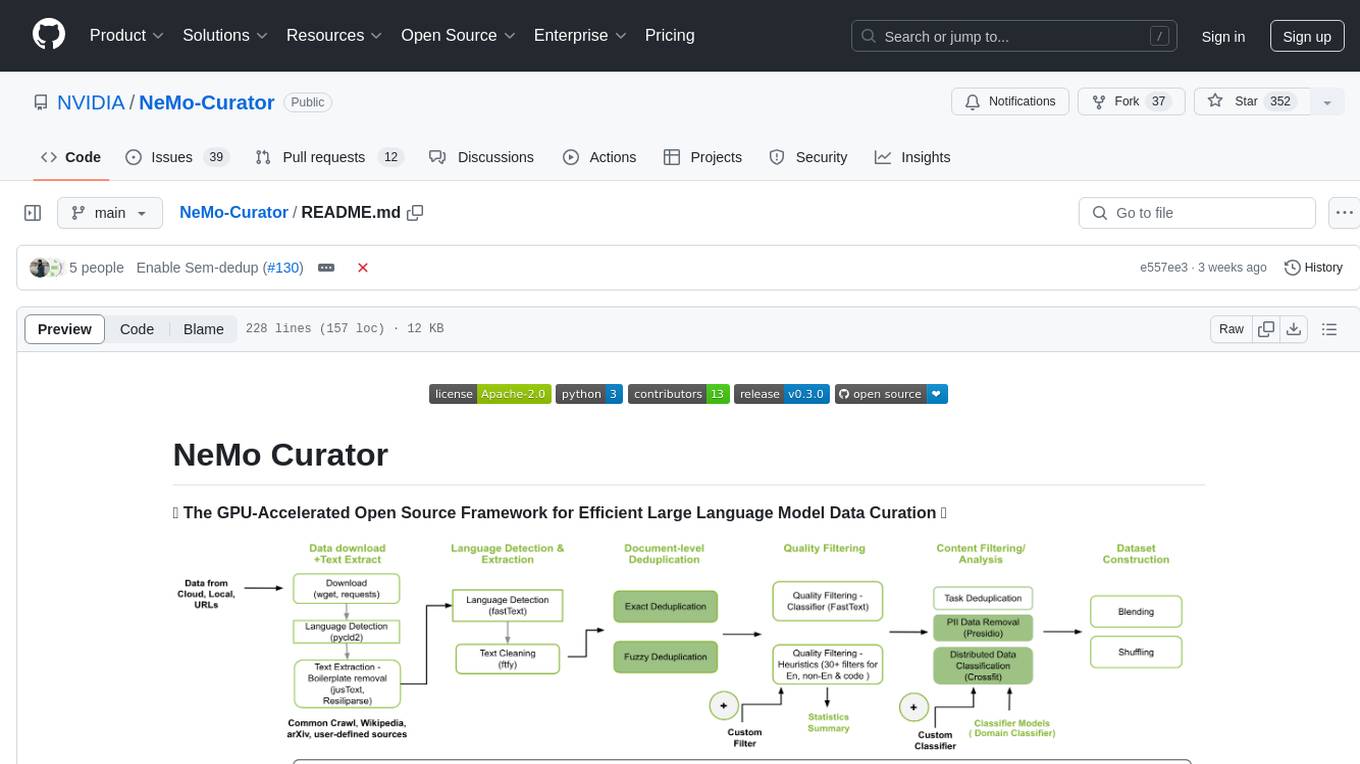
NeMo-Curator
NeMo Curator is a GPU-accelerated open-source framework designed for efficient large language model data curation. It provides scalable dataset preparation for tasks like foundation model pretraining, domain-adaptive pretraining, supervised fine-tuning, and parameter-efficient fine-tuning. The library leverages GPUs with Dask and RAPIDS to accelerate data curation, offering customizable and modular interfaces for pipeline expansion and model convergence. Key features include data download, text extraction, quality filtering, deduplication, downstream-task decontamination, distributed data classification, and PII redaction. NeMo Curator is suitable for curating high-quality datasets for large language model training.
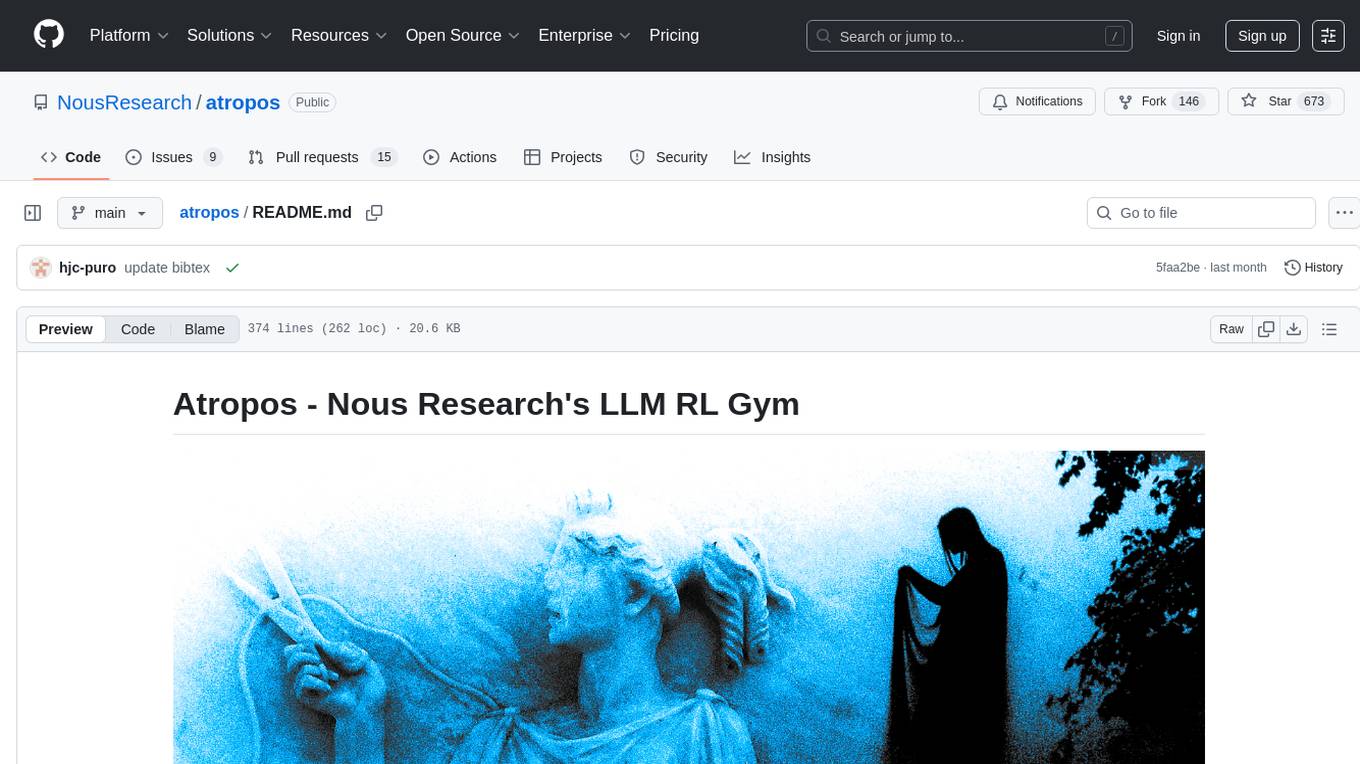
atropos
Atropos is a robust and scalable framework for Reinforcement Learning Environments with Large Language Models (LLMs). It provides a flexible platform to accelerate LLM-based RL research across diverse interactive settings. Atropos supports multi-turn and asynchronous RL interactions, integrates with various inference APIs, offers a standardized training interface for experimenting with different RL algorithms, and allows for easy scalability by launching more environment instances. The framework manages diverse environment types concurrently for heterogeneous, multi-modal training.
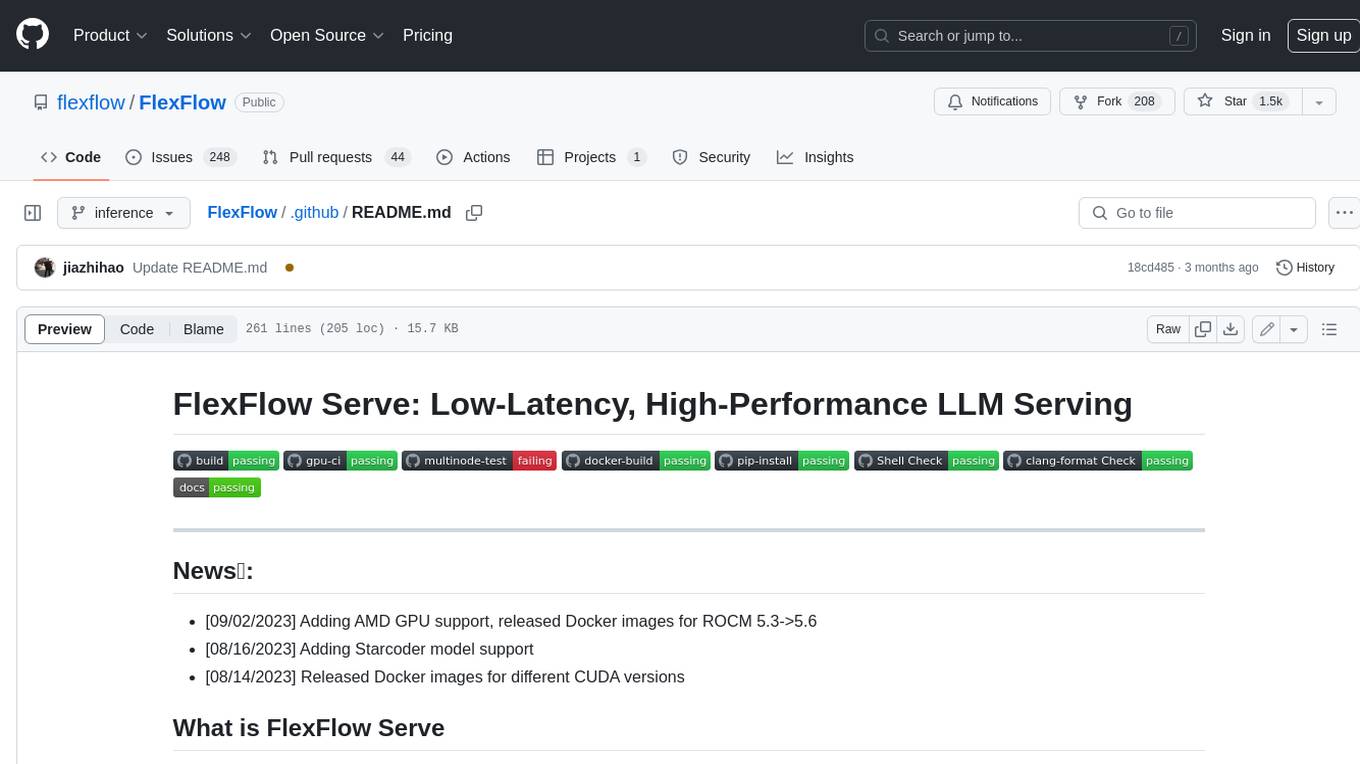
FlexFlow
FlexFlow Serve is an open-source compiler and distributed system for **low latency**, **high performance** LLM serving. FlexFlow Serve outperforms existing systems by 1.3-2.0x for single-node, multi-GPU inference and by 1.4-2.4x for multi-node, multi-GPU inference.
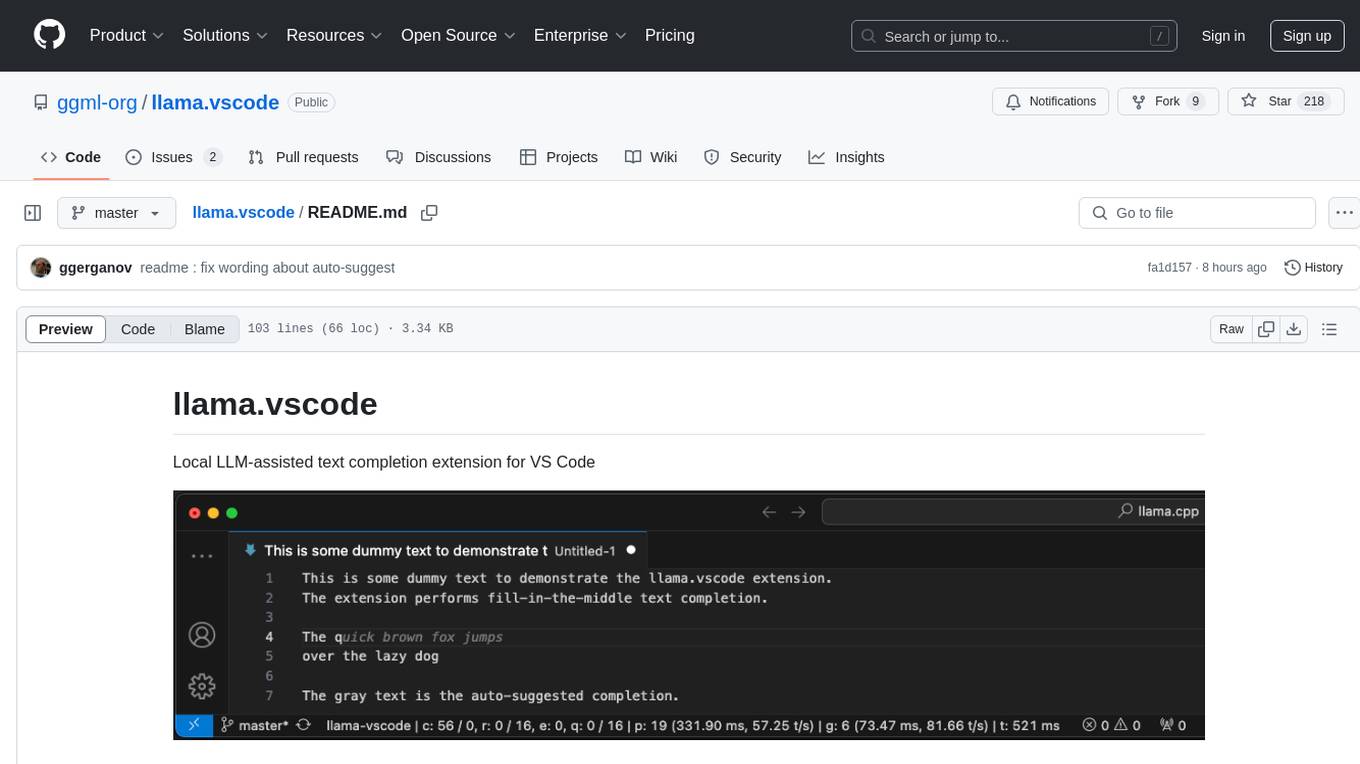
llama.vscode
llama.vscode is a local LLM-assisted text completion extension for Visual Studio Code. It provides auto-suggestions on input, allows accepting suggestions with shortcuts, and offers various features to enhance text completion. The extension is designed to be lightweight and efficient, enabling high-quality completions even on low-end hardware. Users can configure the scope of context around the cursor and control text generation time. It supports very large contexts and displays performance statistics for better user experience.
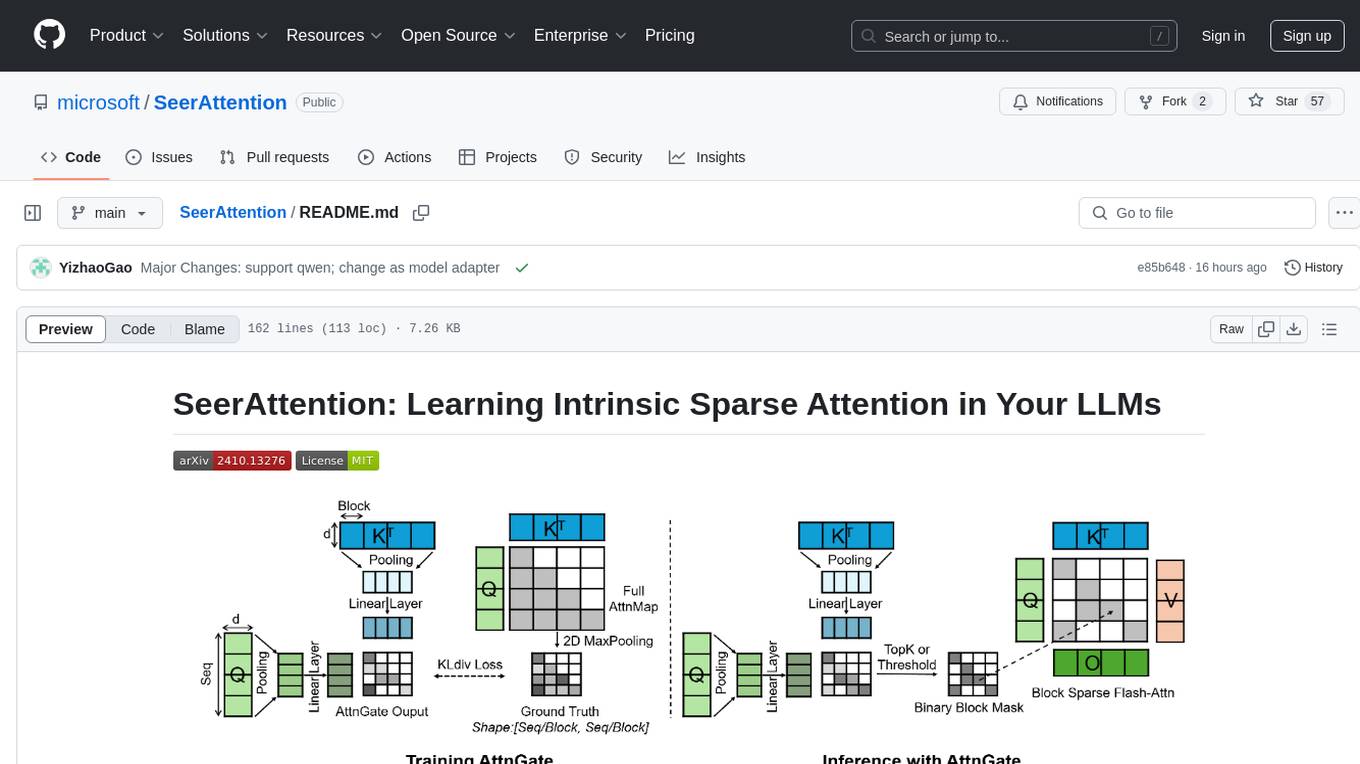
SeerAttention
SeerAttention is a novel trainable sparse attention mechanism that learns intrinsic sparsity patterns directly from LLMs through self-distillation at post-training time. It achieves faster inference while maintaining accuracy for long-context prefilling. The tool offers features such as trainable sparse attention, block-level sparsity, self-distillation, efficient kernel, and easy integration with existing transformer architectures. Users can quickly start using SeerAttention for inference with AttnGate Adapter and training attention gates with self-distillation. The tool provides efficient evaluation methods and encourages contributions from the community.
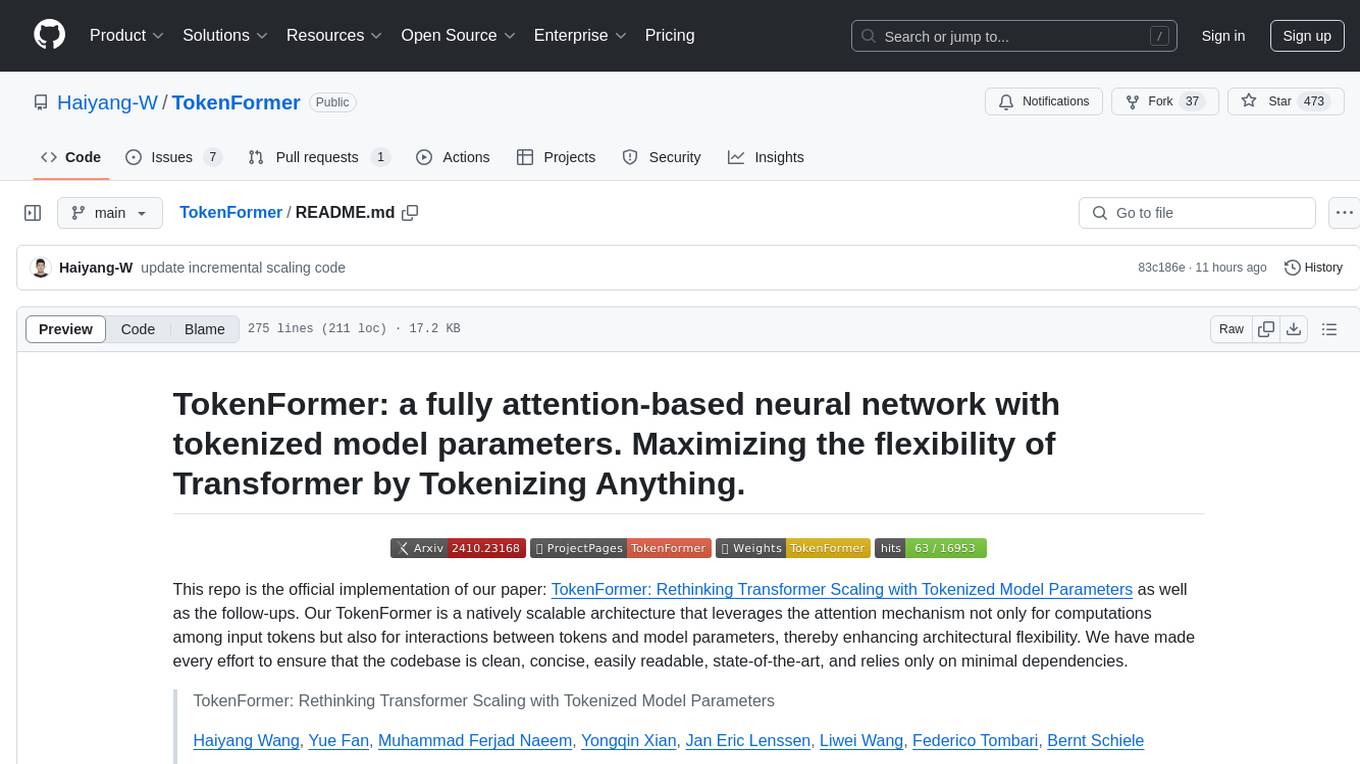
TokenFormer
TokenFormer is a fully attention-based neural network architecture that leverages tokenized model parameters to enhance architectural flexibility. It aims to maximize the flexibility of neural networks by unifying token-token and token-parameter interactions through the attention mechanism. The architecture allows for incremental model scaling and has shown promising results in language modeling and visual modeling tasks. The codebase is clean, concise, easily readable, state-of-the-art, and relies on minimal dependencies.
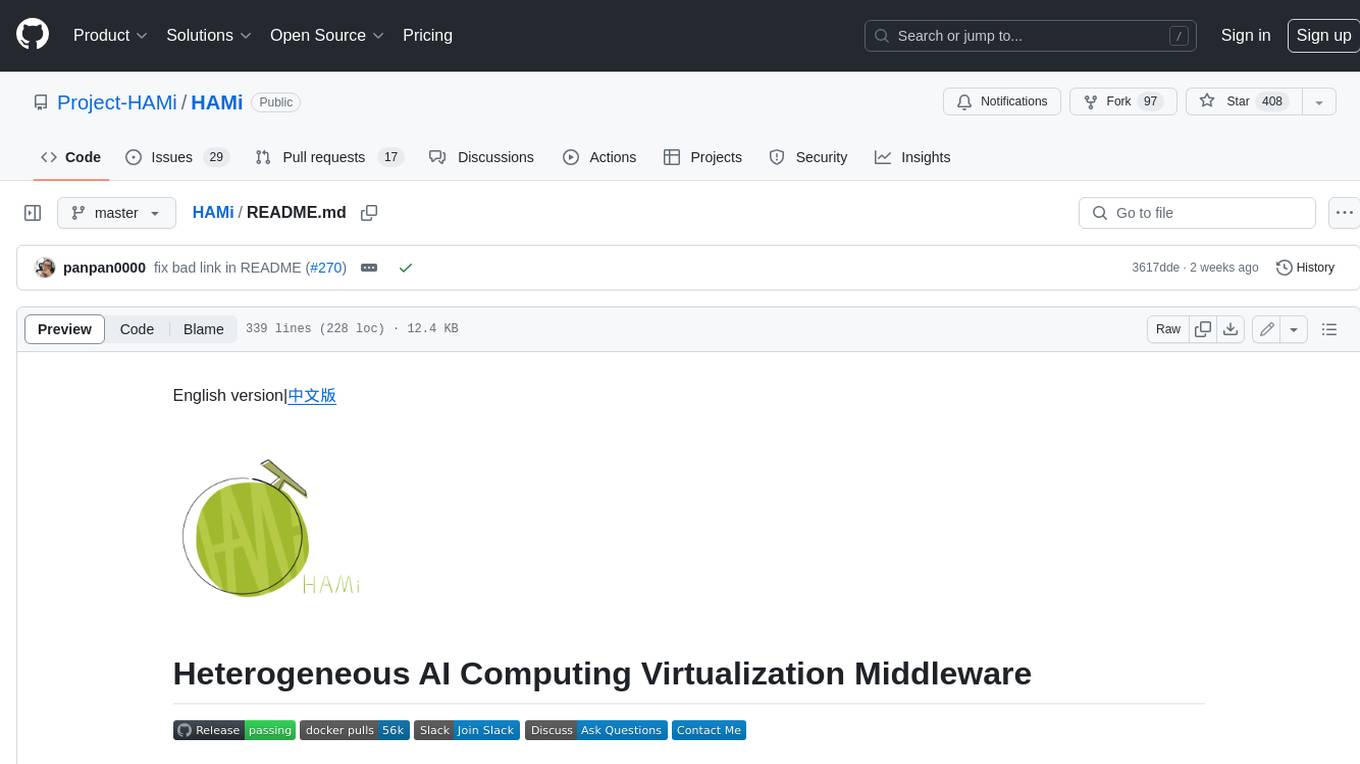
HAMi
HAMi is a Heterogeneous AI Computing Virtualization Middleware designed to manage Heterogeneous AI Computing Devices in a Kubernetes cluster. It allows for device sharing, device memory control, device type specification, and device UUID specification. The tool is easy to use and does not require modifying task YAML files. It includes features like hard limits on device memory, partial device allocation, streaming multiprocessor limits, and core usage specification. HAMi consists of components like a mutating webhook, scheduler extender, device plugins, and in-container virtualization techniques. It is suitable for scenarios requiring device sharing, specific device memory allocation, GPU balancing, low utilization optimization, and scenarios needing multiple small GPUs. The tool requires prerequisites like NVIDIA drivers, CUDA version, nvidia-docker, Kubernetes version, glibc version, and helm. Users can install, upgrade, and uninstall HAMi, submit tasks, and monitor cluster information. The tool's roadmap includes supporting additional AI computing devices, video codec processing, and Multi-Instance GPUs (MIG).
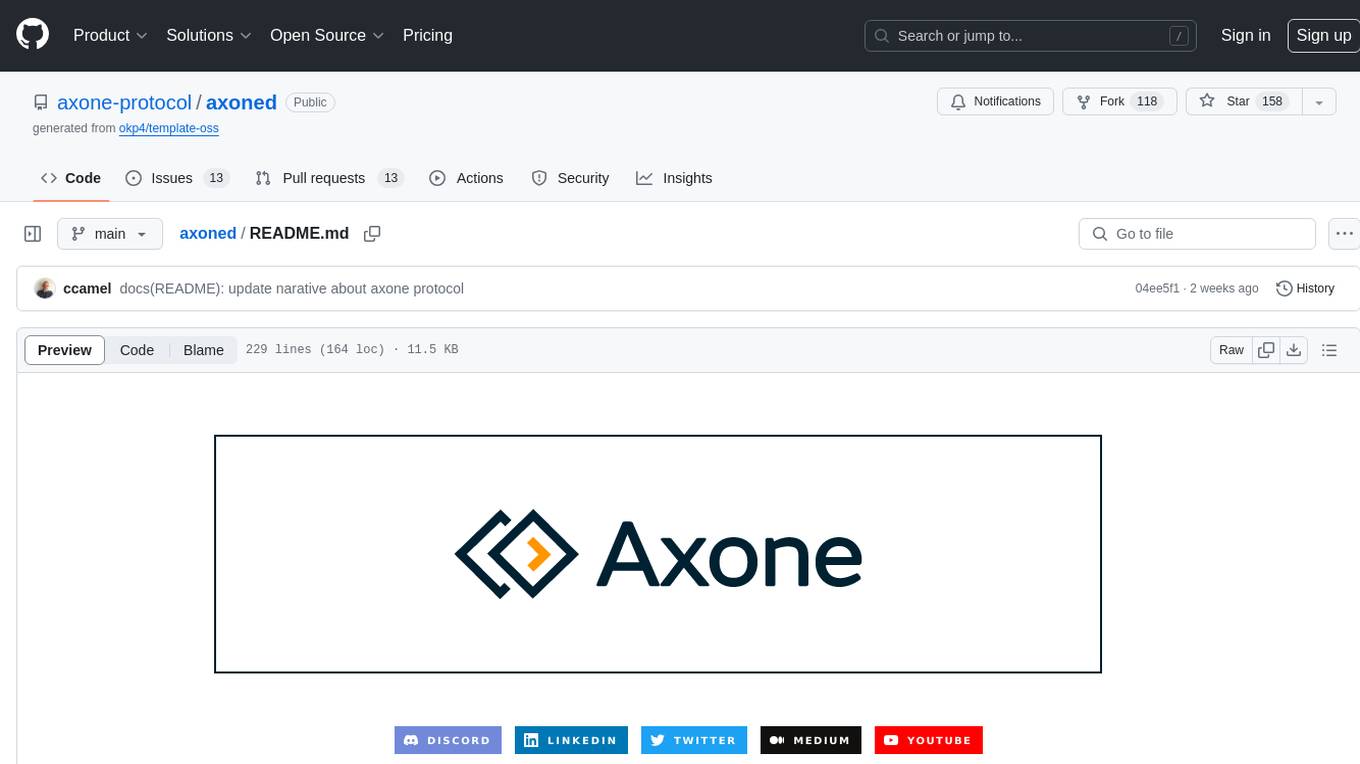
axoned
Axone is a public dPoS layer 1 designed for connecting, sharing, and monetizing resources in the AI stack. It is an open network for collaborative AI workflow management compatible with any data, model, or infrastructure, allowing sharing of data, algorithms, storage, compute, APIs, both on-chain and off-chain. The 'axoned' node of the AXONE network is built on Cosmos SDK & Tendermint consensus, enabling companies & individuals to define on-chain rules, share off-chain resources, and create new applications. Validators secure the network by maintaining uptime and staking $AXONE for rewards. The blockchain supports various platforms and follows Semantic Versioning 2.0.0. A docker image is available for quick start, with documentation on querying networks, creating wallets, starting nodes, and joining networks. Development involves Go and Cosmos SDK, with smart contracts deployed on the AXONE blockchain. The project provides a Makefile for building, installing, linting, and testing. Community involvement is encouraged through Discord, open issues, and pull requests.
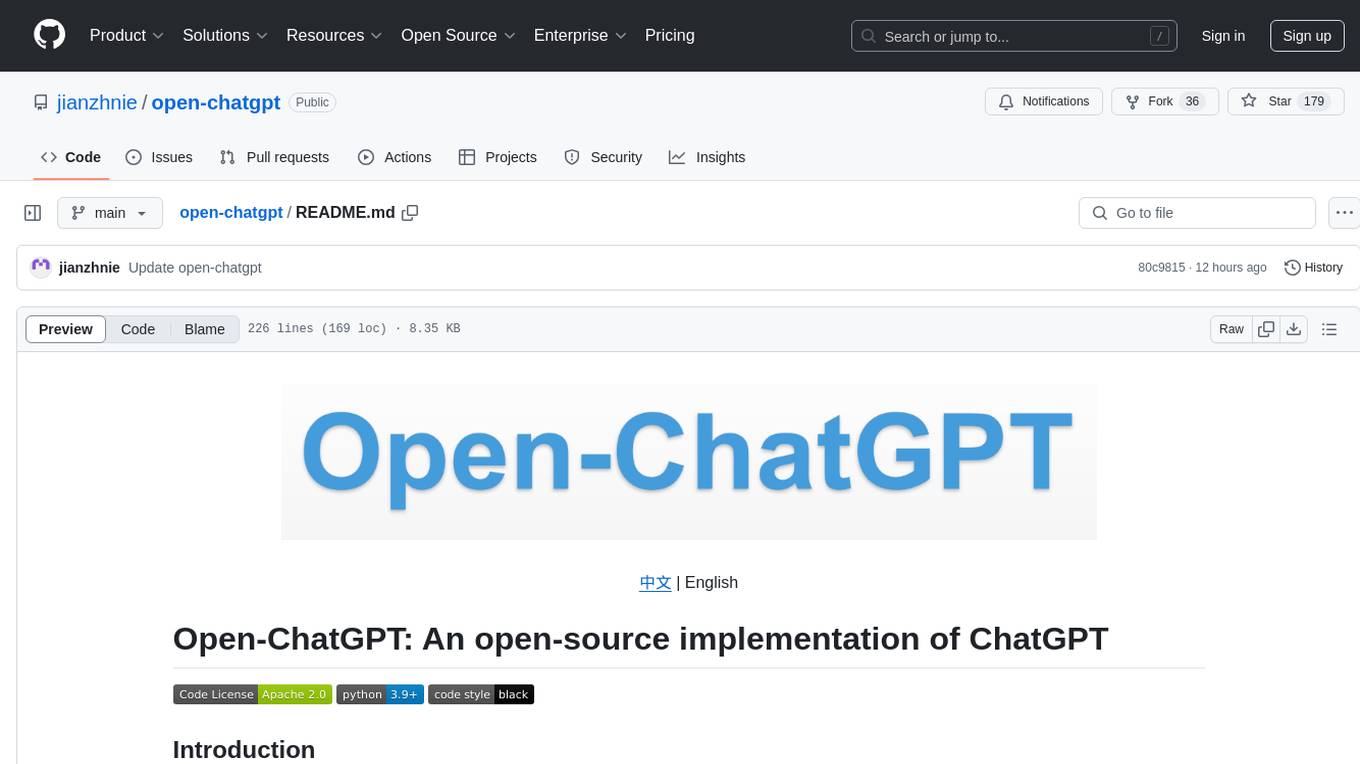
open-chatgpt
Open-ChatGPT is an open-source library that enables users to train a hyper-personalized ChatGPT-like AI model using their own data with minimal computational resources. It provides an end-to-end training framework for ChatGPT-like models, supporting distributed training and offloading for extremely large models. The project implements RLHF (Reinforcement Learning with Human Feedback) powered by transformer library and DeepSpeed, allowing users to create high-quality ChatGPT-style models. Open-ChatGPT is designed to be user-friendly and efficient, aiming to empower users to develop their own conversational AI models easily.
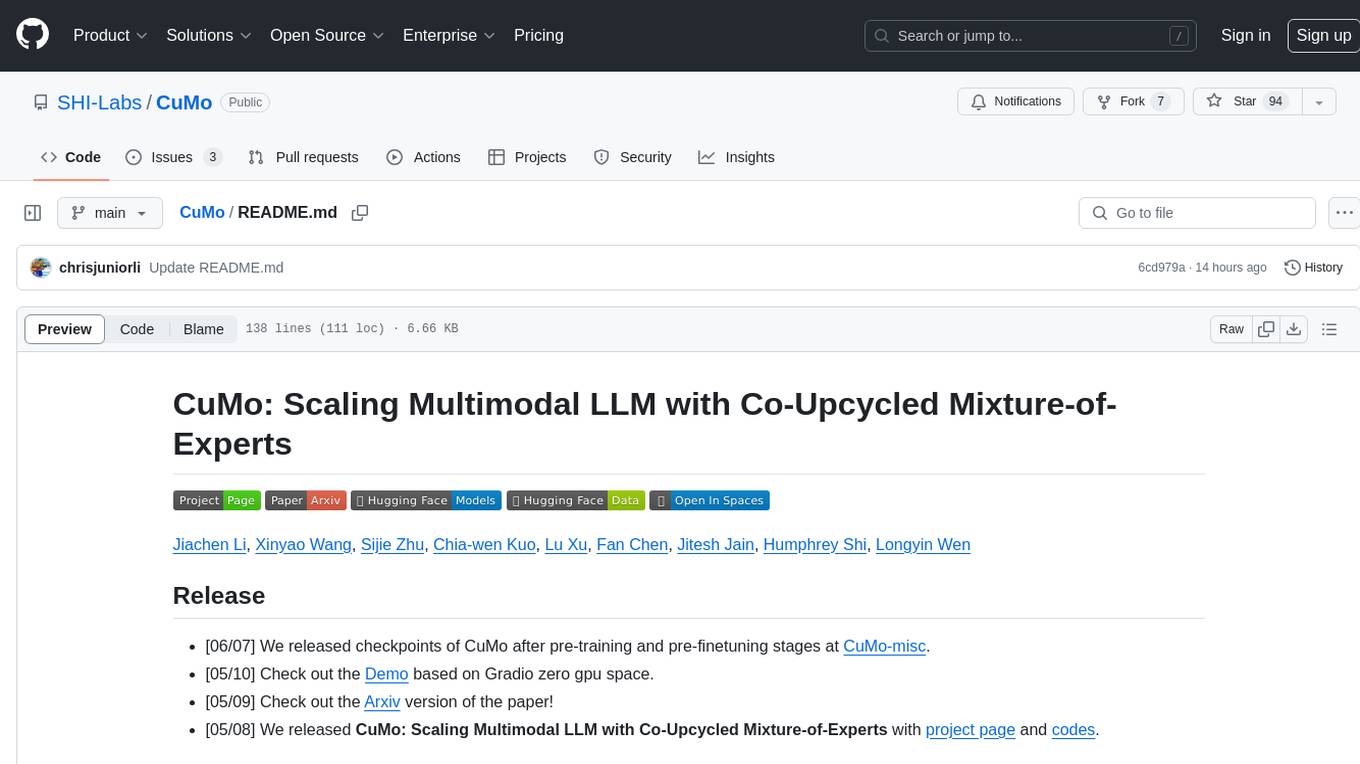
CuMo
CuMo is a project focused on scaling multimodal Large Language Models (LLMs) with Co-Upcycled Mixture-of-Experts. It introduces CuMo, which incorporates Co-upcycled Top-K sparsely-gated Mixture-of-experts blocks into the vision encoder and the MLP connector, enhancing the capabilities of multimodal LLMs. The project adopts a three-stage training approach with auxiliary losses to stabilize the training process and maintain a balanced loading of experts. CuMo achieves comparable performance to other state-of-the-art multimodal LLMs on various Visual Question Answering (VQA) and visual-instruction-following benchmarks.
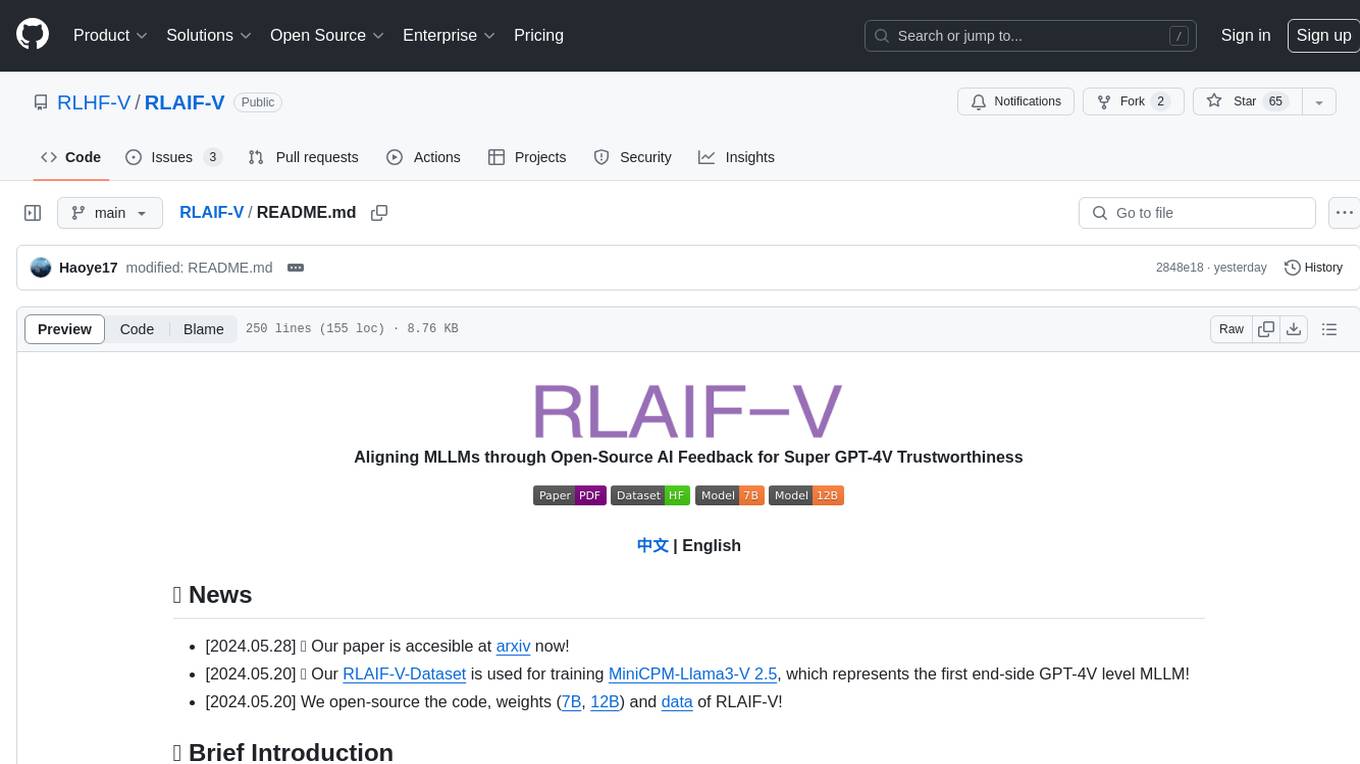
RLAIF-V
RLAIF-V is a novel framework that aligns MLLMs in a fully open-source paradigm for super GPT-4V trustworthiness. It maximally exploits open-source feedback from high-quality feedback data and online feedback learning algorithm. Notable features include achieving super GPT-4V trustworthiness in both generative and discriminative tasks, using high-quality generalizable feedback data to reduce hallucination of different MLLMs, and exhibiting better learning efficiency and higher performance through iterative alignment.
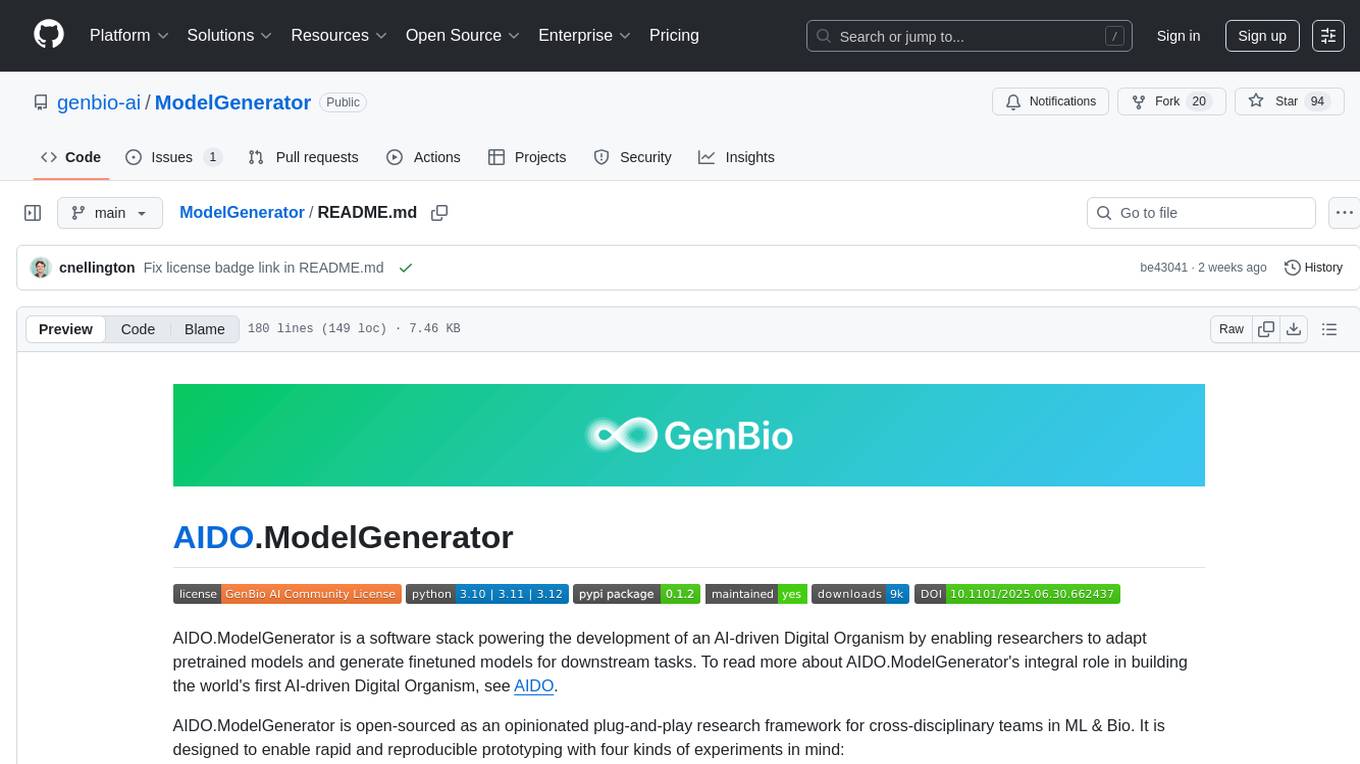
ModelGenerator
AIDO.ModelGenerator is a software stack designed for developing AI-driven Digital Organisms. It enables researchers to adapt pretrained models and generate finetuned models for various tasks. The framework supports rapid prototyping with experiments like applying pre-trained models to new data, developing finetuning tasks, benchmarking models, and testing new architectures. Built on PyTorch, HuggingFace, and Lightning, it facilitates seamless integration with these ecosystems. The tool caters to cross-disciplinary teams in ML & Bio, offering installation, usage, tutorials, and API reference in its documentation.
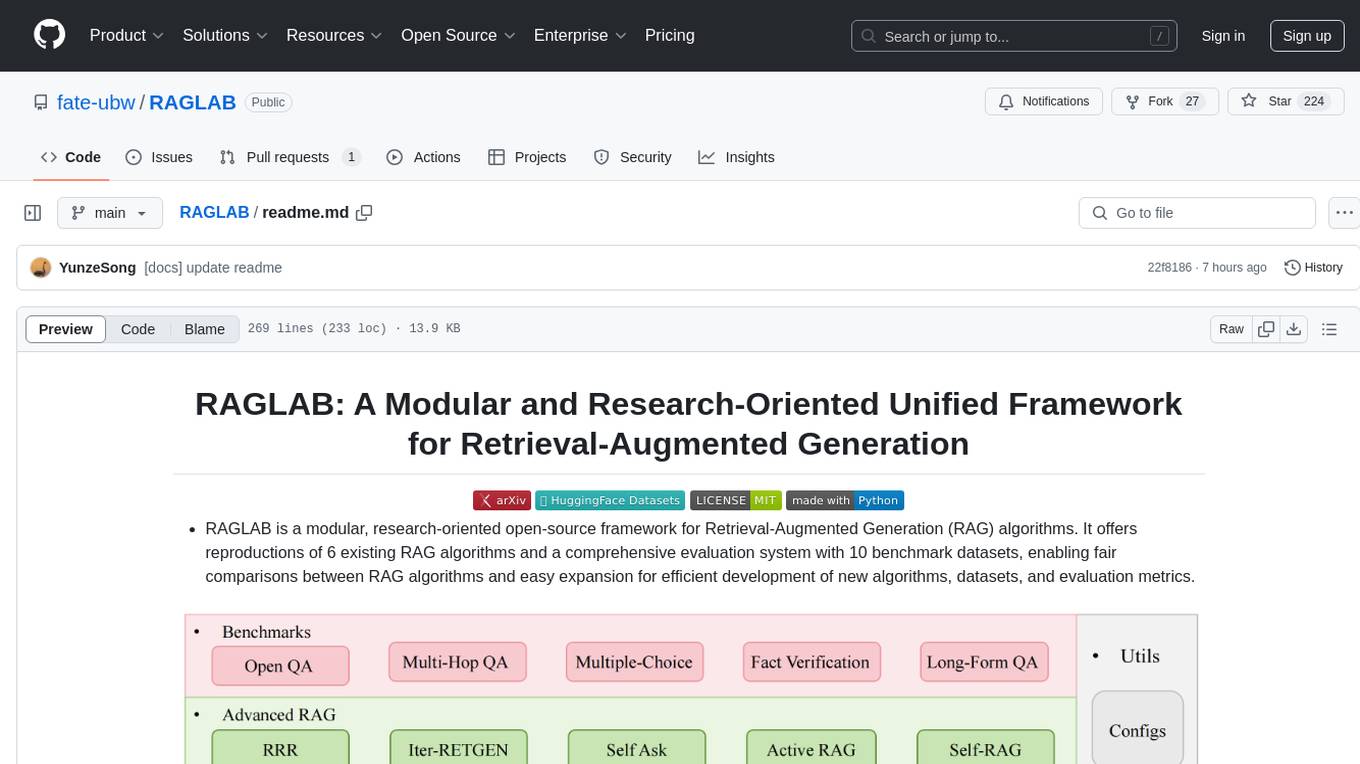
RAGLAB
RAGLAB is a modular, research-oriented open-source framework for Retrieval-Augmented Generation (RAG) algorithms. It offers reproductions of 6 existing RAG algorithms and a comprehensive evaluation system with 10 benchmark datasets, enabling fair comparisons between RAG algorithms and easy expansion for efficient development of new algorithms, datasets, and evaluation metrics. The framework supports the entire RAG pipeline, provides advanced algorithm implementations, fair comparison platform, efficient retriever client, versatile generator support, and flexible instruction lab. It also includes features like Interact Mode for quick understanding of algorithms and Evaluation Mode for reproducing paper results and scientific research.
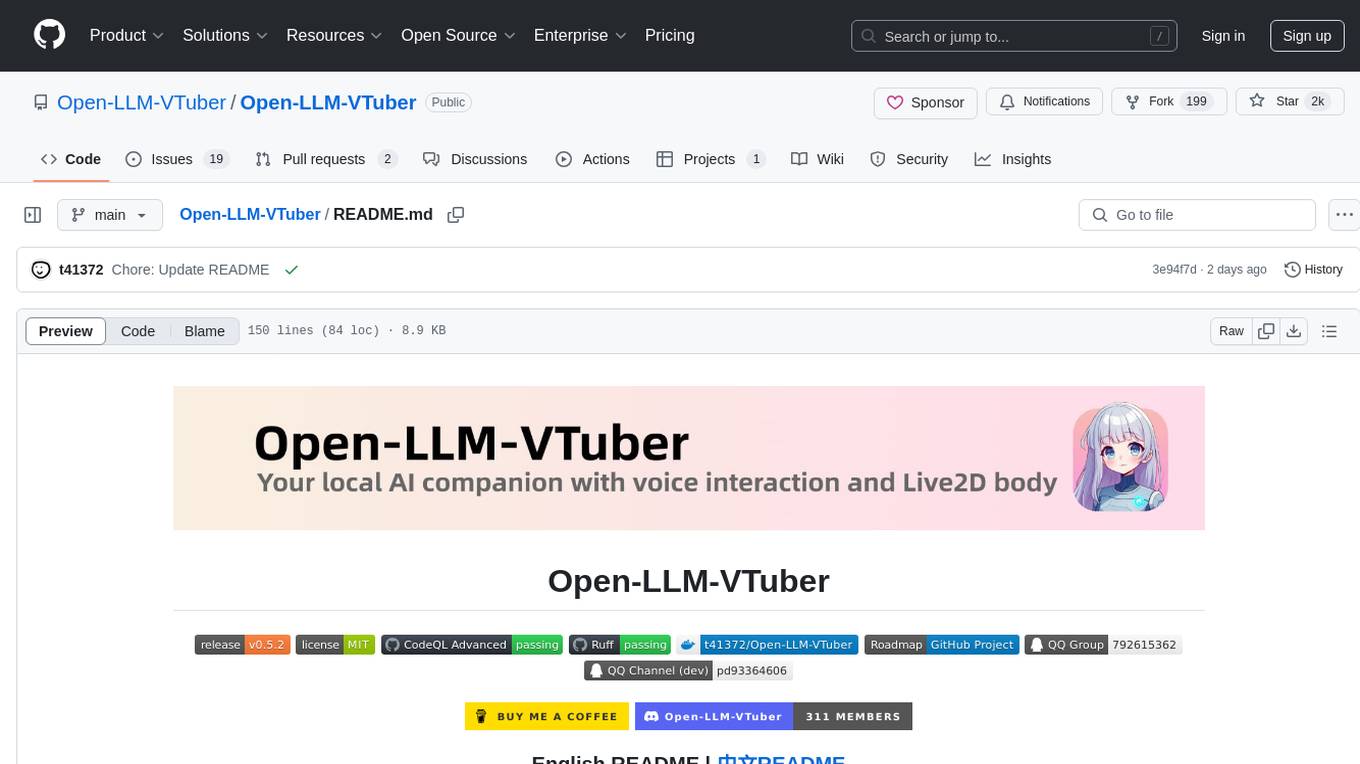
Open-LLM-VTuber
Open-LLM-VTuber is a voice-interactive AI companion supporting real-time voice conversations and featuring a Live2D avatar. It can run offline on Windows, macOS, and Linux, offering web and desktop client modes. Users can customize appearance and persona, with rich LLM inference, text-to-speech, and speech recognition support. The project is highly customizable, extensible, and actively developed with exciting features planned. It provides privacy with offline mode, persistent chat logs, and various interaction features like voice interruption, touch feedback, Live2D expressions, pet mode, and more.
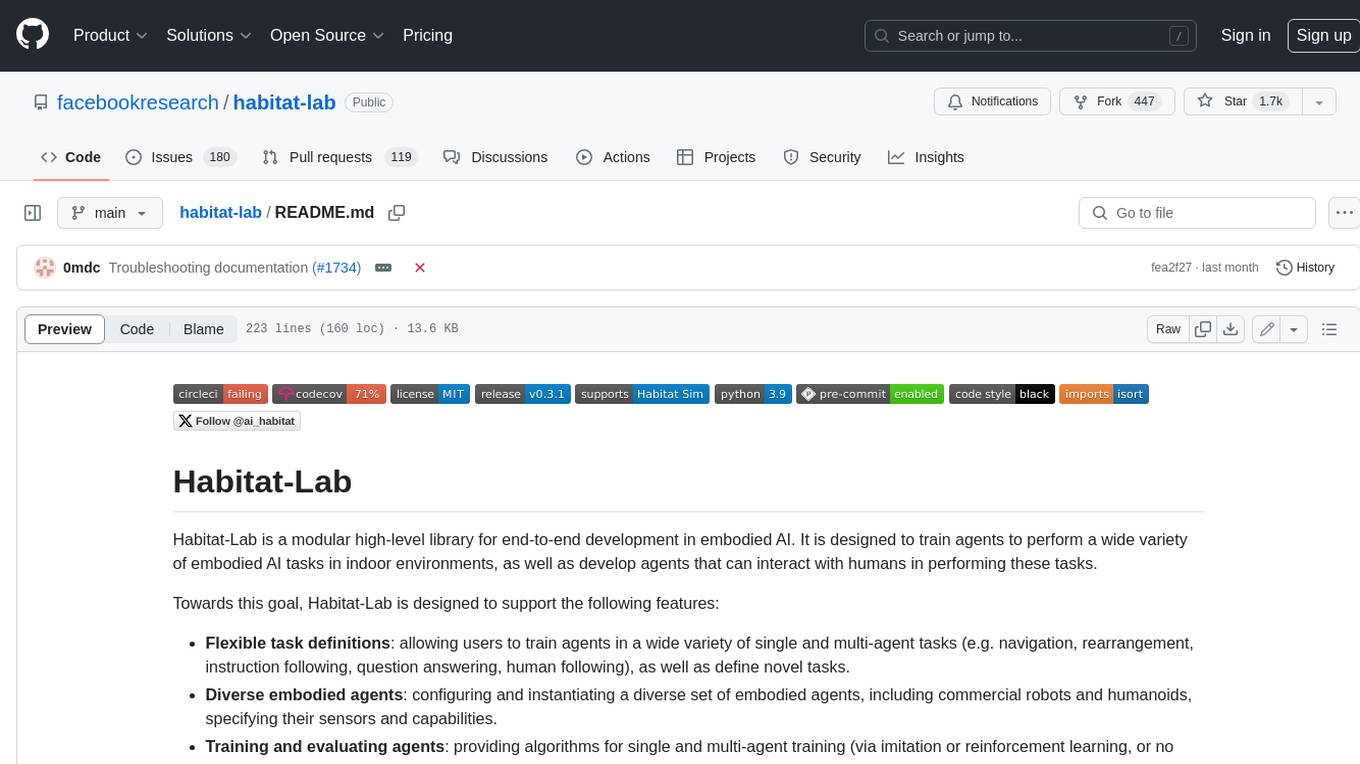
habitat-lab
Habitat-Lab is a modular high-level library for end-to-end development in embodied AI. It is designed to train agents to perform a wide variety of embodied AI tasks in indoor environments, as well as develop agents that can interact with humans in performing these tasks.
For similar tasks

PowerInfer
PowerInfer is a high-speed Large Language Model (LLM) inference engine designed for local deployment on consumer-grade hardware, leveraging activation locality to optimize efficiency. It features a locality-centric design, hybrid CPU/GPU utilization, easy integration with popular ReLU-sparse models, and support for various platforms. PowerInfer achieves high speed with lower resource demands and is flexible for easy deployment and compatibility with existing models like Falcon-40B, Llama2 family, ProSparse Llama2 family, and Bamboo-7B.
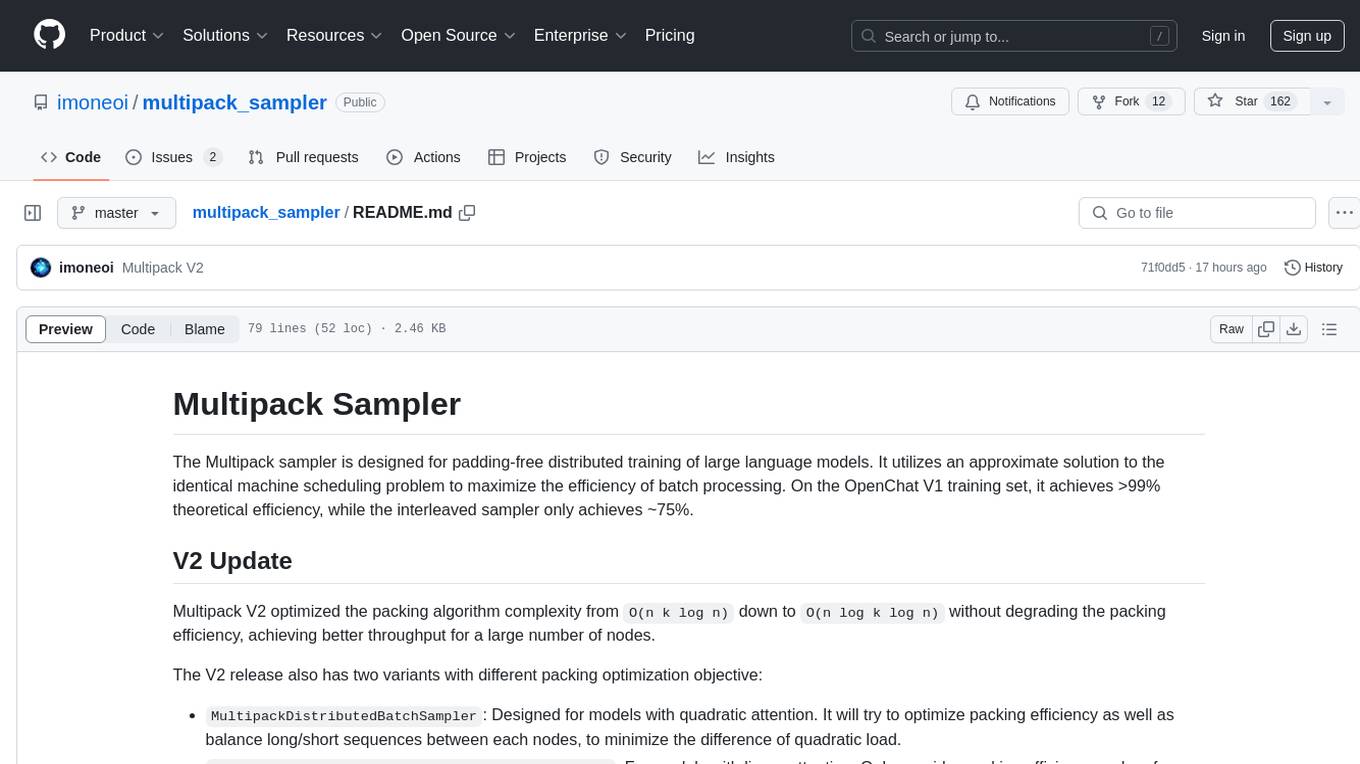
multipack_sampler
The Multipack sampler is a tool designed for padding-free distributed training of large language models. It optimizes batch processing efficiency using an approximate solution to the identical machine scheduling problem. The V2 update further enhances the packing algorithm complexity, achieving better throughput for a large number of nodes. It includes two variants for models with different attention types, aiming to balance sequence lengths and optimize packing efficiency. Users can refer to the provided benchmark for evaluating efficiency, utilization, and L^2 lag. The tool is compatible with PyTorch DataLoader and is released under the MIT license.
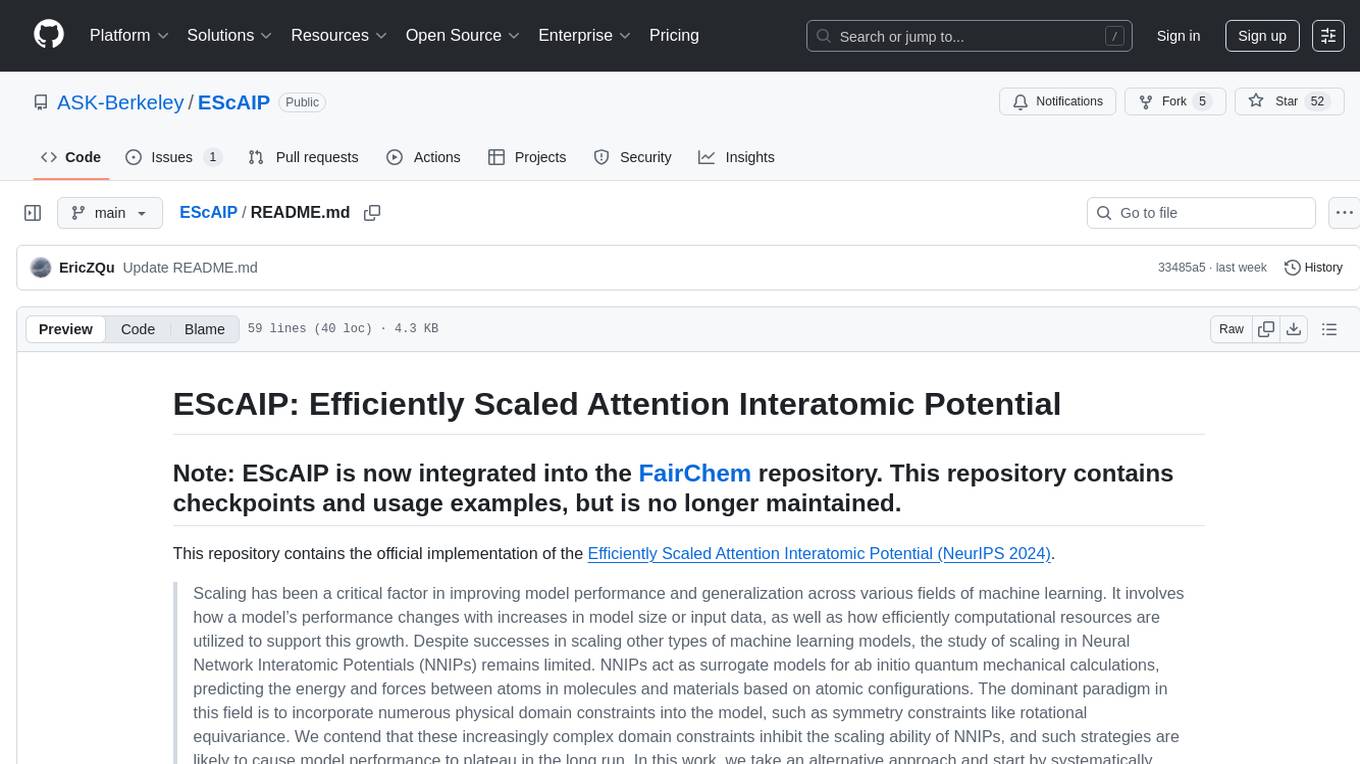
EScAIP
EScAIP is an Efficiently Scaled Attention Interatomic Potential that leverages a novel multi-head self-attention formulation within graph neural networks to predict energy and forces between atoms in molecules and materials. It achieves substantial gains in efficiency, at least 10x speed up in inference time and 5x less memory usage compared to existing models. EScAIP represents a philosophy towards developing general-purpose Neural Network Interatomic Potentials that achieve better expressivity through scaling and continue to scale efficiently with increased computational resources and training data.
For similar jobs

weave
Weave is a toolkit for developing Generative AI applications, built by Weights & Biases. With Weave, you can log and debug language model inputs, outputs, and traces; build rigorous, apples-to-apples evaluations for language model use cases; and organize all the information generated across the LLM workflow, from experimentation to evaluations to production. Weave aims to bring rigor, best-practices, and composability to the inherently experimental process of developing Generative AI software, without introducing cognitive overhead.

LLMStack
LLMStack is a no-code platform for building generative AI agents, workflows, and chatbots. It allows users to connect their own data, internal tools, and GPT-powered models without any coding experience. LLMStack can be deployed to the cloud or on-premise and can be accessed via HTTP API or triggered from Slack or Discord.

VisionCraft
The VisionCraft API is a free API for using over 100 different AI models. From images to sound.

kaito
Kaito is an operator that automates the AI/ML inference model deployment in a Kubernetes cluster. It manages large model files using container images, avoids tuning deployment parameters to fit GPU hardware by providing preset configurations, auto-provisions GPU nodes based on model requirements, and hosts large model images in the public Microsoft Container Registry (MCR) if the license allows. Using Kaito, the workflow of onboarding large AI inference models in Kubernetes is largely simplified.

PyRIT
PyRIT is an open access automation framework designed to empower security professionals and ML engineers to red team foundation models and their applications. It automates AI Red Teaming tasks to allow operators to focus on more complicated and time-consuming tasks and can also identify security harms such as misuse (e.g., malware generation, jailbreaking), and privacy harms (e.g., identity theft). The goal is to allow researchers to have a baseline of how well their model and entire inference pipeline is doing against different harm categories and to be able to compare that baseline to future iterations of their model. This allows them to have empirical data on how well their model is doing today, and detect any degradation of performance based on future improvements.

tabby
Tabby is a self-hosted AI coding assistant, offering an open-source and on-premises alternative to GitHub Copilot. It boasts several key features: * Self-contained, with no need for a DBMS or cloud service. * OpenAPI interface, easy to integrate with existing infrastructure (e.g Cloud IDE). * Supports consumer-grade GPUs.

spear
SPEAR (Simulator for Photorealistic Embodied AI Research) is a powerful tool for training embodied agents. It features 300 unique virtual indoor environments with 2,566 unique rooms and 17,234 unique objects that can be manipulated individually. Each environment is designed by a professional artist and features detailed geometry, photorealistic materials, and a unique floor plan and object layout. SPEAR is implemented as Unreal Engine assets and provides an OpenAI Gym interface for interacting with the environments via Python.

Magick
Magick is a groundbreaking visual AIDE (Artificial Intelligence Development Environment) for no-code data pipelines and multimodal agents. Magick can connect to other services and comes with nodes and templates well-suited for intelligent agents, chatbots, complex reasoning systems and realistic characters.
